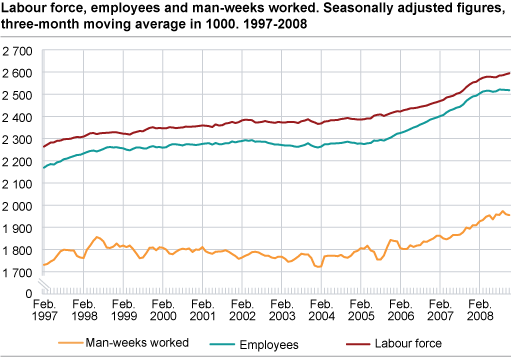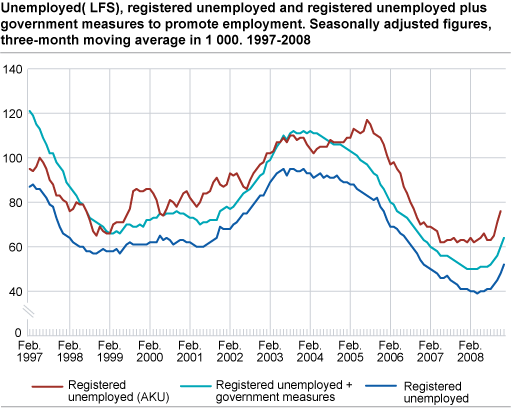Content
Published:
This is an archived release.
Fewer on temporary contracts
The number of employed people on temporary contracts fell by 17 000 from the fourth quarter of 2007 to the fourth quarter of 2008.
Seasonally adjusted figures: Rising unemploymentAdjusted for seasonal variations, unemployment increased while employment was stable, from the third quarter of 2008 to the fourth quarter of 2008. Adjustments for seasonal variations allow for the analysis of current developments in the labour market, and serve as an alternative to comparisons with the corresponding quarter in the previous year. Seasonally adjusted figures are presented in a separate article . |
There was a decline of people on temporary contracts in several industries. In total, 190 000 people were on temporary contracts in the fourth quarter of 2008. Employed people on temporary contracts constituted 8.2 per cent of total employment, a reduction from 9.0 per cent in the fourth quarter of 2007. Education and social work had the largest shares on temporary contracts. These industries employed more than 40 per cent of all the people on temporary contracts.
Employment growth halved
From the fourth quarter of 2007 to the fourth quarter of 2008, employment rose by 41 000. The growth was reduced by half since last quarter. In the period from the third quarter of 2007 to the third quarter of 2008, employment rose by 83 000. The change in the growth rate is obvious in most industries in the private sector.
The number in employment in health and social work increased by 28 000 from the fourth quarter in 2007 to the fourth quarter in 2008.
Stable participation rate
The labour force (the sum of employment and unemployment) increased by 53 000 from the fourth quarter of 2007 to the fourth quarter of 2008. In the same period, the working-age population (aged 15-74) rose by 60 000. This means that the overall labour force participation rate (the labour force as a percentage of the working-age population) was about the same as in the fourth quarter of 2007. The labour force participation rate for women (the labour force as a percentage of the female working-age population) was 70.4 per cent, up 0.4 percentage points compared to the same quarter in 2007. For men, the labour force participation rate was 76.4 per cent, about the same as in the fourth quarter of 2007.
More women in full-time employment
Full-time employment was up by approximately 33 000, almost 70 per cent among women. The share in full-time employment among women increased from the fourth quarter of 2007 to the fourth quarter of 2008, while decreasing for men. The average settled working hours for men was 37.0 hours per week, compared with 31.1 hours for women.
Increasing unemployment
According to the LFS, the unemployment figure increased by 12 000 from the fourth quarter of 2007 to the fourth quarter of 2008. The unemployment rate stood at 2.6 per cent in the fourth quarter of 2008, while it was 2.1 per cent in the same quarter in 2007. Unemployment has particularly increased among people aged 15-24.
Both the number unemployed and the share of unemployed with less than three months searching for work went up from the fourth quarter of 2007 to the fourth quarter of 2008. The average length of job searches was down by 3.5 weeks from the fourth quarter in 2007. This means an increasing inflow to unemployment.
The share of underemployment down
Underemployment is employees with part-time settled working hours who have tried to find more work. The number of underemployed was 53 000 in the fourth quarter of 2008, 5 000 less than in the fourth quarter of 2007. In the fourth quarter of 2008, the underemployed represented 7.8 per cent of all part-time employees, down from 8.7 per cent in the same quarter in 2007.
When accounting for the fact that many unemployed and most underemployed are looking for less than full-time work, these two groups together wanted work that corresponds to 73 000 full-time equivalents in the fourth quarter of 2008 - up 7 000 from the fourth quarter of 2007. The increase was among the unemployed, while the amount of work supplied among the underemployed was about the same as in the fourth quarter of 2007.
Tables:
- Table 1. Population aged 15-74(1) in the labour force, man-weeks worked, unemployed (LFS)(2), registered unemployed persons and persons employed by government measures (NAV). 1000 and per cent
- Table 2. Population aged 15-74(1) in the labour force, employed persons and unemployed persons by sex (LFS)(2). 1000 and per cent
- Table 3. Persons in the labour force and employed persons by age and sex (LFS). 1 000 and per cent
- Table 4. Population aged 15-74, employed persons by contractual/usual working hours per week(1) and unemployed persons by age and sex (LFS). 1000
- Table 5. Persons in the labour force aged 15-74 by age and sex. 1000 and as per cent of all in each group
- Table 6. Employed persons aged 15-74, by sex and settled/usual working hours pr week (LFS). 1 000
- Table 7. Population aged 15-74, by main activity, part-time employment 1 and age (LFS). 1 000
- Table 8. Employed persons aged 15-74 by major industry division (LFS). 1000
- Table 9. Number of man-hours worked per week, by industry division (LFS). 1 000
- Table 10. Employed persons aged 15-74, total, and employed persons at work by status and sex. Number of man-weeks worked and actual working hours per week (LFS).
- Table 11. Employed persons aged 15-74 and absence from work(1) during the whole reference week by reason for absence and sex (LFS). 1000 and per cent
- Table 12. Employees aged 15-74 with temporary jobs, by major industry division (LFS). 1000 and as per cent of all employees
- Table 13. Unemployed persons aged 15-74 by sex and age (LFS). 1000 and per cent
- Table 14. Unemployed persons aged 15-74 by duration of job search (LFS). 1000 and per cent
- Table 15. Unemployed persons aged 15-74, by main activity (LFS). 1 000
- Table 16. Unemployed and underemployed persons aged 15-74, by sex and desired working hours per week. Number of man-weeks (of 37,5 hours) supplied (LFS). 1000
- Table 18. Persons in the labour force aged 15-74, by sex and region (LFS) 2. 1 000 and in per cent of total
- Table 19. Employed persons aged 15-74, by sex and region (LFS) 1 000
- Table 20. Employed persons aged 15-74, by sex and regions (LFS) as per cent of all inn each group
- Table 21 Employed persons, by some major industry division and region (LFS). 1997-2008. 1 000
Contact
-
Arbeidsmarked og lønn
E-mail: arbeidsmarked@ssb.no
-
Erik Herstad Horgen
E-mail: erik.horgen@ssb.no
tel.: (+47) 93 08 68 62
-
Håvard Hungnes Lien
E-mail: havard.lien@ssb.no
tel.: (+47) 40 90 26 06


